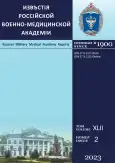Clinical application of neodymium magnetic instruments for the removal of foreign bodies in blind wounds
- 作者: Shvediuk V.V.1, Elin N.E.1, Dzidzava I.I.1, Fufayev E.E.1, Barinov O.V.1
-
隶属关系:
- Military Medical Academy
- 期: 卷 42, 编号 2 (2023)
- 页面: 105-114
- 栏目: Original articles
- URL: https://bakhtiniada.ru/RMMArep/article/view/316024
- DOI: https://doi.org/10.17816/rmmar346674
- ID: 316024
如何引用文章
详细
A feature of modern military conflicts is the high frequency of shrapnel wounds. The search for foreign bodies, even under X-ray navigation, can be technically difficult, lengthy and not always successful. Most injuring objects have ferromagnetic properties.
AIM: The Military Medical Academy, Saint Petersburg purpose of the study: to evaluate the effectiveness of removing ferromagnetic foreign bodies from blind wounds using neodymium magnetic instruments.
MATERIALS AND METHODS: Instruments based on a neodymium magnet for removing foreign bodies and a technique for their use have been developed. An analysis was made of 45 operations where traditional instruments were used and 75 operations using original magnetic instruments. Of these, in 40 cases of blind wounds, foreign bodies were removed from the soft tissues of various areas, and in 35 cases, foreign bodies were removed during videothoracoscopy operations for blind penetrating chest wounds. The criteria for evaluating the effectiveness of the method were the duration of the operation, the duration of work with the X-ray unit and the number of detected and removed foreign bodies in a fixed period of time.
CONCLUSION: High efficiency, simplicity, accessibility, minimally invasiveness of the developed instruments have been proven. Neodymium magnets made it possible to reduce the time of radiation exposure and the duration of the operation, to increase the efficiency of removing ferromagnetic foreign bodies. The use of original instruments makes it possible to detect 80% of foreign bodies in 10 minutes, and within 30 minutes to remove 90% of foreign bodies from the soft tissues of the wounded. With videothoracoscopy, the time of fluoroscopy was halved, and the total duration of the surgical intervention was reduced by 40%.
作者简介
Viktor Shvediuk
Military Medical Academy
Email: viktorgx72@gmail.com
ORCID iD: 0000-0003-1294-6488
SPIN 代码: 3645-7526
M.D., Ph.D. (Medicine)
俄罗斯联邦, Saint PetersburgNikita Elin
Military Medical Academy
编辑信件的主要联系方式.
Email: elinnikita28@yandex.ru
cadet of 5th year of the 2nd faculty
俄罗斯联邦, Saint PetersburgIlya Dzidzava
Military Medical Academy
Email: dzi-dzava@mail.ru
ORCID iD: 0000-0002-5860-3053
SPIN 代码: 7336-9643
Scopus 作者 ID: 8901380100
Researcher ID: Q-1992-2016
M.D., D.Sc. (Medicine), Associate Professor
俄罗斯联邦, Saint PetersburgEvgeniy Fufayev
Military Medical Academy
Email: fufaev.jj@gmail.com
SPIN 代码: 5758-2364
Scopus 作者 ID: 55342047800
M.D., Ph.D. (Medicine), Associate Professor
俄罗斯联邦, Saint PetersburgOleg Barinov
Military Medical Academy
Email: Barinov_o@mail.ru
ORCID iD: 0000-0003-0084-8338
SPIN 代码: 4999-2314
Scopus 作者 ID: 37004230300
Researcher ID: ABG-7142-2021
M.D., D.Sc. (Medicine), Associate Professor
俄罗斯联邦, Saint Petersburg参考
- Gumanenko EK, Samokhvalov IM, eds. Military field surgery of local wars. Moscow: GEOTAR-Media Publ.; 2011. 704 p. (In Russ.)
- Kotiv BN, Samokhvalov IM, Chuprina AP, et al. Guidelines for military field surgery. Moscow: GVMU MO RF Publishing House; 2020. P. 30–52. (In Russ.)
- Kryukov EV, Davydov DV, Khominets VV, et al. Staged treatment of the wounded with injuries of the musculoskeletal systems in modern armed conflict. Military Medical Journal. 2023;344(3):4–17. (In Russ.) doi: 10.52424/00269050_2023_344_3_4
- Ivchenko EV, Anisin AV, Tyurin MV, Titov RV. The experimental research of the mine-blast injuries of pelvic limb and working out treatment’s principles. Bulletin of the Russian Military Medical Academy. 2011;(4):94–96. (In Russ.)
- Koval’ AN, Tashkinov NV, Melkonyan GG, et al. Optimization of the technique for removing radiopaque foreign bodies of soft tissues. Yakut medical journal. 2020:(1(69)):112–115. (In Russ.)
- Kolesnikov IS. Removal of foreign bodies from the pleural cavity, lungs and mediastinum. Kupriyanov PA, ed. Moscow: Publishing House of the USSR Academy of Medical Sciences; 1949. 252 p. (In Russ.)
- Smirnov EI. War and military medicine: thoughts and memories 1939–1945. Moscow: Meditsina Publ.; 1976. 463 p. (In Russ.)
- Ozeretskovsky LB. Wound ballistics. Saint Petersburg: Kalashnikov magazine Publishing House; 2006. 373 p. (In Russ.)
- Elin NE, Shvedyuk VV. Experimental substantiation of instruments based on neodymium magnet for extracting foreign bodies from wounds. In: Materialy itogovoy konferentsii VNOKS VMedA im. S.M. Kirova. Saint Petersburg: VMedA Publishing House; 2023. P. 183–189. (In Russ.)
- Shvedyuk VV, Elin NE, Boytsova YuA. Magnetic finger diagnostics and extraction of foreign bodies. In: Ivchenko EV, ed. Improvement of methods and equipment used in the educational process, biomedical research and clinical practice. Saint Petersburg: VMedA Publishing House; 2023. (In Russ.)
- Spedding FH, Daan AH, comp. The Rare Earth Elements. Ukolov KV, et al. translated from English; prof. Savitsky EM, ed. Moscow: Metallurgiya Publ.; 1965. 610 p. (In Russ.)
- Patakhov GM, Akhmadudinov MG, Akhmadudinov AM, Khalilov MA. A tool for extracting foreign ferromagnetic objects from wounds and body cavities. Patent RU203097 U1. Makhachkala: DSMU Publishing House; 2021. 7 p. (In Russ.)
- Shvedyuk VV, Elin NE, Boytsova YuA. Flexible magnetic extractor. In: Ivchenko EV, ed. Improvement of methods and equipment used in the educational process, biomedical research and clinical practice. Saint Petersburg: VMedA Publishing House; 2023. (In Russ.)
补充文件













